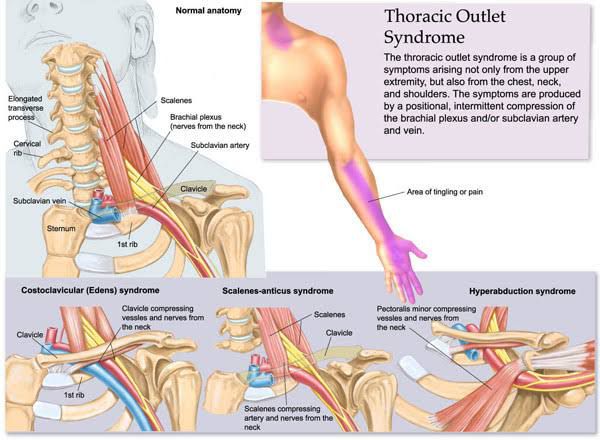THORACIC OUTLET SYNDROME
Thoracic outlet syndrome is a term used for several rare and different conditions that can occur
when nerves and/or blood vessels in the thoracic outlet are compressed or irritated.
The thoracic outlet is the space between the collarbone (clavicle) and the first rib. This narrow
passageway is crowded with blood vessels, muscles, and nerves. If the shoulder muscles in the
chest are not strong enough to hold the collarbone in place, it can slip down and forward, putting
pressure on the nerves and blood vessels that lie under it. This causes a variety of symptoms which
together are known as thoracic outlet syndrome.
Cause:
Thoracic outlet syndrome can result from:
- An injury
- A disease
- A congenital problem (something you are born with), such as an abnormal first rib. The
condition is more common in women than in men, and poor posture and obesity can
aggravate the condition.
- Psychological changes are often seen in patients with thoracic outlet syndrome. It is not
clear whether these changes are a cause or result of the syndrome.
Symptoms
The following are common signs of thoracic outlet syndrome:
- Pressure on the nerves (brachial plexus) may cause:
A vague, aching pain in the neck, shoulder, arm, or hand
Pain, numbness, or tingling on the inside of the forearm and the fourth and fifth fingers of the hand
Weakness that may make your hand clumsy.
- Pressure on the blood vessels can reduce the flow of blood out of your arm, resulting in
swelling, redness, or other discoloration of your arm. Less commonly, pressure can reduce
the blood flow into your arm and hand, making them feel cool and easily fatigued (tired).
- Overhead activities are particularly difficult because they worsen both types of
compression as the rib, collarbone, and/or shoulder blade compress the nerves and blood
vessels.
- Range of motion may be limited.
Special tests:
- Elevated Arm Stress/ Roos test - Used to provoke symptoms by maintaining a stressed
position of the neurovascular bundle; commonly used for suspected neurogenic TOS.
- Upper Limb Tension Test - Assesses neural mobility and tension along the brachial plexus
and peripheral nerves.[4]
- Cervical Rotation Lateral Flexion Test - Helps assess for the presence of a cervical rib or
structural narrowing in the interscalene triangle.
Treatment:
Conservative management should be the first strategy to treat TOS since this seems to be effective
at decreasing symptoms, facilitating return to work, and improving function.
STAGE 1
The aim of the initial stage is to decrease the patient’s symptoms. This may be achieved by patient
education, in which TOS, bad postures, the prognosis and the importance of therapy compliance
are explained.
STAGE 2
Once the patient has control over his/her symptoms, the patient can move to this stage of treatment.
The goal of this stage is to directly address the tissues that create structural limitations of motion
and compression.
- Massage
- Strengthening of the levator scapulae, sternocleidomastoid and upper trapezius (This group
of muscles open the thoracic outlet by raising the shoulder girdle and opening the
costoclavicular space)
- Stretching of the pectoralis, lower trapezius and scalene muscles (These muscles close the
thoracic outlet)
- Postural correction exercises
- Relaxation of shortened muscles
- Aerobic exercises in a daily home exercise program.
Thoracic outlet syndrome (TOS) presents a complex challenge, involving compression of
neurovascular structures in the thoracic outlet. It demands a comprehensive approach to diagnosis
and management, encompassing both conservative and surgical interventions. Physical therapy
plays a crucial role in symptom management and rehabilitation, focusing on patient education,
posture correction, strengthening, and stretching exercises. Surgical options, when necessary, aim
to alleviate compression and restore function. Postoperative physical therapy is essential for
optimizing recovery and preventing complications.




